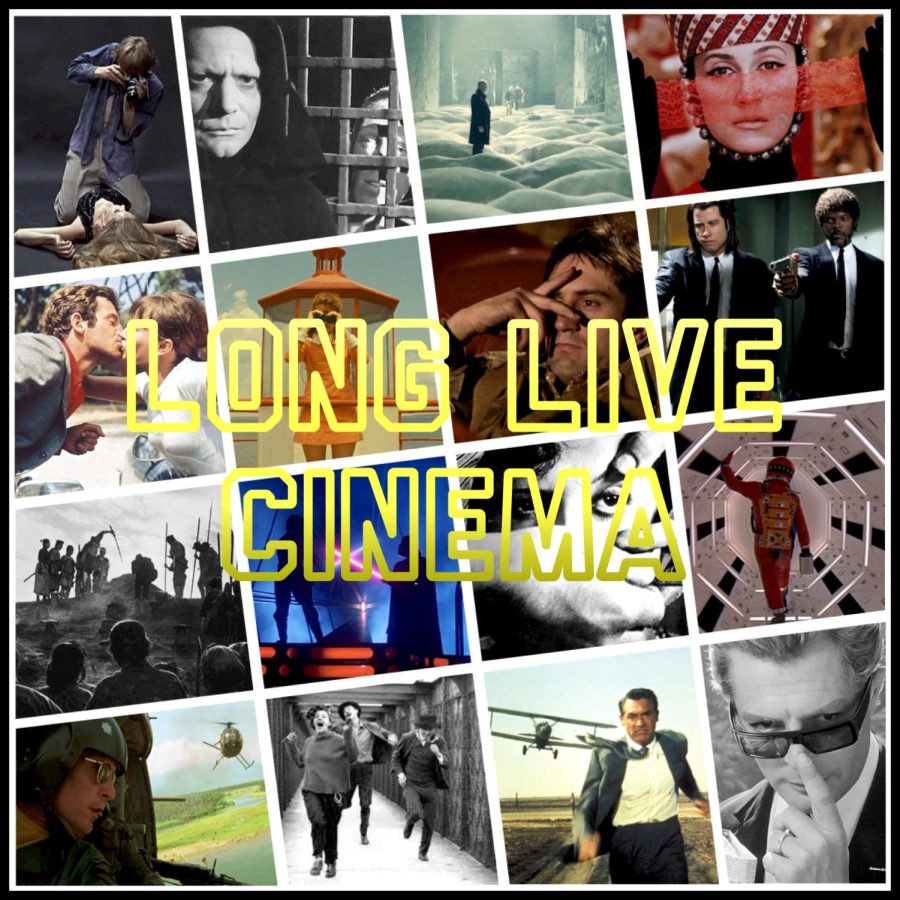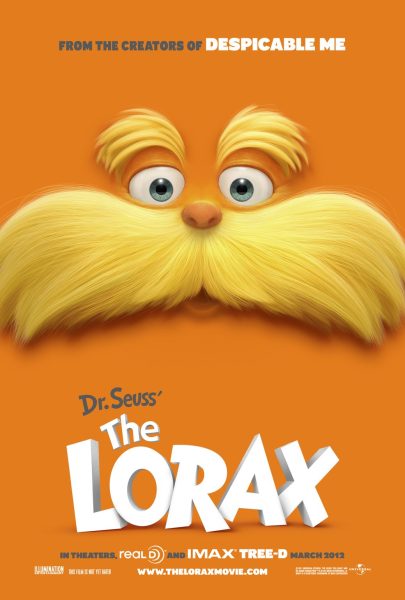Is Cinema Dying?
November 15, 2022
The earliest stories told by humans can be discovered etched in the walls of caves dating back roughly 2.5 million years ago during the paleolithic period. A figurative cave painting depicting a Celebes warty pig found within the Maros-Pangkep karst in Sulawesi was estimated to be at least 43,900 years old and recorded to be the “oldest pictorial record of storytelling and the earliest figurative artwork in the world.” To these early Homo sapiens, the caves were their canvas, and they were only just figuring out what the canvas could become.
With the conception of visual storytelling, there would appear a desire to reinterpret life through abstraction that evokes a transcendental quality in order to make sense of our existence. With each century, new storytelling methods would emerge, from manipulating silhouette figures in shadow puppetry to the gleaming projections emitted by a magic lantern.
Many concepts and devices that were introduced during the 18th & 19th centuries would become referred to as “philosophical toys,” or “optical toys,” and later be regarded as the precursors to the later art and techniques of cinema. While some of these inventions were utilized by pioneers of Cinema, many of the devices were standalone experiments or simple scientific amusements. The purpose of these devices was to create an optical phenomenon known as “persistence of vision” and the phi phenomenon.
The former refers to the optical illusion that occurs when visual perception of an object does not cease for some time after the rays of light proceeding from it have ceased to enter the eye. The human eye and brain can only process about 12 separate images per second and retain an image of 1/16 seconds. To create motion by utilizing persistence of vision, one image is shown for every frame at a total of 12 images per second, allowing for even faster motion, or alternatively, one image can be shown for every two frames at a total of 12 frames per second, which makes it possible to create smoother motion.
The phi phenomenon refers to an optical illusion in which stationary objects shown in rapid succession, transcending the threshold at which then can be perceived separately, appear to move. The Gestalt School of psychology defined and coined this term in 1912, showing that perception goes beyond our senses.
At this point in time, pre-cinema started to move towards cinema with the invention of photography. The first photograph was taken in 1826 by French scientist Jospeh Nicephore Niepce, titled “View from the Window at Le Gras”. Niepce produced this photo by exposing a bitumen-coated plate in a camera obscura for several hours. French chemist Louis Daguerre sought an attempt at improving the photographic process that Niepce had worked on, leading to the daguerreotype which is like today’s Polaroid. The process involves a sheet of copper plated with a thin coat of silver. After cleaning the plate, it is sensitized in a light box with iodine and bromine vapors until its surface turns yellow. Following exposure to light, the plate would be developed over hot mercury until an image appeared. After, the plate was removed and washed with a sodium solution, cleansed, washed with gold chloride, and then heated so that the image was fixed onto the plate without the image fading. The Daguerreotype became a catalyst for the vision of photography and gave rise to picture factories.
Some decades later during the 1870s, a bet was wagered between British American inventor Eadweard Muybridge and his employer California Governor Leland Stanford. Stanford owned a large farm at which he bred, trained, and raced horses. Stanford approached Muybridge and tasked him with capturing a galloping horse lifting all four hooves off the ground at once. Muybridge aimed to prove this theory by setting up multiple cameras with wires that stretch across the racetrack. The horse would trip each shutter to expose a successive photo of the gallop. These series of 12 cabinet cards captured the horse in motion confirming Stanford’s belief and cementing The Horse in Motion as the first motion picture ever made.
In 1891, American inventors Thomas A. Edison and William Dickson produced the Kinetoscope, an early motion picture exhibition device for motion pictures to be viewed by a single person through a peephole viewer window. This invention marks the transition of cinema moving from obscurity towards the colossal industry it would ultimately become. At this point, films of this era could be described as illuminating, albeit primitive.
In France, two Parisian brothers, Louis and Auguste Lumiere, sought to revolutionize the medium of cinema on a global scale. Both brothers worked for their father’s photographic equipment business. The Lumiere brothers used another invention of Edison’s labs, the kinetograph, and improved the original design by correcting several flaws, allowing for sharper images and better lighting. Unlike the kinetoscope, the Lumiere’s Cinematographe could project an image onto a screen so a large gathering of people could view images simultaneously as opposed to a single person.
Their invention would see success around the world following their initial screening in 1895 of their first film titled Workers Leaving the Lumiere Factory, which was presented along with ten other short films at Salon Indien du Grand Café in Paris. The balance of light and shadow, the clarity of the workers shuffling out of the building; it was no longer an illusion but represented real life on a stage.
The Lumiere’s presented their films in a way that appears performative, solidifying Europe as the more experimental and auteur side of cinema, as opposed to Edison and the United States’ studio style of cinema. The Lumiere brothers’ eagerness to capture and create eclipsed the business absorbed Edison who then scrambled to invent his own contraption for projecting films, the Vitascope. No matter, the Cinematograph came out as the more successful of the two as it became the de facto mode of screen projection.
Everything in cinema derives from these inventions, and in the ensuing years, film continued to evolve. New technologies such as special-effects became common leading to advancements in animated movies. Cinema encapsulated a sense of wonder and thrill that explored visceral feelings and complex characters, all the while presenting something truly new and unexpected. People went to see movies in theaters, it became an inherent part of the film’s experience to be surrounded by strangers cast in the shadows of a dimly lit theater. It became a passion for many.
Around the 1950s in Europe, revolutionary ideas and art movements such as Italian Neorealism and the French New Wave gave rise to cinephilia. Before this time, the Hollywood way of film dominated the market from the late 1920s – 1960s. Many directors such as Orson Welles or Erich von Stroheim were obtrude out into artistic exile in Europe. Film magazines, such as Cahiers du Cinema, became a popular forum for film enthusiasts. Clubs specializing in films from the past and director retrospectives popped up around Europe. For the next few decades, movie-going was a popular pastime. Many film masterpieces came out weekly during this era and for many it was a great time to be alive. With the advent of television along with streaming becoming the main source of watching new films, independent theaters and film exhibitions are being suffocated.
Things are changing for sure, but in recent years franchise films began to dominate theaters as their only offerings. Major media conglomerates were quick to catch on to the fact that projects attached to already established properties were more successful financially than original ideas. This brought a surge of remakes, sequels, reboots, and franchises in theaters. Netflix stepped in as ticket sales dwindled, reluctantly allowing some of its films to be released in theaters to qualify for academy awards. Many other large studios and media companies followed suit by releasing their own streaming services ushering in an age of content defined by its commercial economic viability rather than promoting and encouraging great art. Nowadays, TV shows are looking more like movies split into multiple pieces while movies are becoming more like TV shows featuring a recurring cast of characters drawn-out over multiple episodes. Contributing to this are new technologies such as computers and smartphones that have expanded how we consume movies and TV shows.
For someone who has been alive for half of cinema’s short history as an art form, it is saddening to see that something you love so dearly looks to be in danger of extinction. 79-year-old film director Martin Scorsese expounds this sentiment further in his article from The New York Times as well as an essay he wrote for Harper’s Magazine. His concerns for the future of Cinema have stirred up controversy before, especially his comments that superhero movies don’t align with his own definition of Cinema and better reflect rides at a theme park. Many cinephiles felt a sense of validation from his comments, while fans of large franchises like Marvel movies felt attacked. His comment was not meant to be derogatory; in fact, he gives Marvel a lot of credit; it is a matter of personal taste. This new type of film is killing off the type of films that Scorsese and other cinephiles enjoy, and because we don’t have established terms to distinguish between these types of films, it leads to people feeling somewhat offended. Scorsese describes the distinction between the themes of these two film types, adding that Cinema involves visceral themes that become the major climatic points of the film, in contrast, such moments are merely filler between the epic battles or cool character introductions. Many viewers have grown accustomed to instant gratification, the constant witty remarks, and hasty expositions being explained to the audience immediately which completely erodes people’s comprehension and attention span.
Meanwhile, the cultural impact of moving image entertainment-whether movies, TV, YouTube videos, or Tik-Toks is at an all-time high. And in a way, the real struggle for Scorsese’s cinema is not even to differentiate itself from Marvel-Type films; it is to even be able to differentiate itself at all from any kind of moving image entertainment in this vast world of “content.” The way that entertainment is presented today is more defined by its brand identity and its ability to rack in millions of views and people talking about it, this only devalue anything produced by creative artists. Films are no longer treated as art by studios, distributors, or consumers, but only serve to fill space on streaming services that fit in their algorithmically defined genres to keep subscribers and get clicks. The viewer is now just a consumer rather than someone participating in artistic expression.
Creativity has been sapped out of the film industry as a result of remakes and sequels being more commercially viable, leaving us with safe content devoid of any creativity. The best art is supposed to take risks and challenge preconceptions. Although many quality films will not cease to exist, brilliant cinema continues to be pushed towards online platforms rather than on the big screen where filmmakers intended people to watch it. Streaming has also made it harder for people to find great cinema because everything is indistinguishable from one another. The same things that are killing Cinema, are also allowing newer generations to discover film. And for those interested in art form and film history, they now live in an era of unprecedented access.















BIG E • Nov 26, 2022 at 12:46 am
Absolute banger of an article little bro, keep up the good work son.